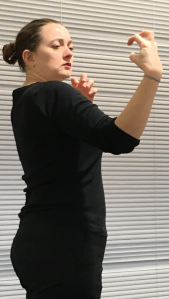‘I regard the theatre as the greatest of all art forms, the most immediate way in which a human being can share with another the sense of what it is to be a human being.’ Thornton Wilder

Sophie Stone in Forest Forge’s ‘Woman of Flowers’ by Kaite O’Reilly. Photo copyright Lucy Sewill.
I’m grateful that the difficult story I was trying to tell in my latest play, ‘Woman of Flowers’ seems to be communicating, and getting great responses. A reinvention of the myth of Blodeuwedd from The Mabinogion, it asks questions about our origins, and our duties, and how to deal with issues of autonomy and desire.
I’ve been obsessed with the story of Blodeuwedd for more years than I care to count. It can be endlessly reinvented, and interpreted through so many different prisms: The ‘perfect’ woman, made from flowers of the forest to be wife to a man cursed by his own mother… The ancient fear of awakened female sexuality and appetite… The amorality of one reared in nature, red in tooth and claw… The politics and rhetoric of belief systems, of honour revenge, of punishment…
I sought to explore this universe created solely by words in visual language, working with Jean St Clair and Sophie Stone in theatricalised sign as well as spoken and projected language. This collaboration between Deaf and hearing cultures has been warmly received by both signing and non-signing audiences, a rare occurrence, and one I feel particularly proud of, and grateful to Jean and Sophie for their willingness to experiment with me.
I was really touched by the thoughtfulness of this recent review:
THE spaces in between the words we say and our thoughts are explored with poetic beauty in Woman Of Flowers, a powerful contemporary reworking of one of the ancient Celtic myths contained in the Welsh treasury known as The Mabinogion
Written by Kaite O’Reilly for the supremely versatile deaf actress Sophie Stone, Woman Of Flowers is at one level a story of duty, desire and revenge, but it operates at many different levels – who are we and where do we come from, how do we reconcile the apparent facts of our life with what we don’t know, what is a woman, what is love, what happens when you want a different life from the one chosen for you?
Rose cannot remember what came before the house at the edge of the isolated forest. Farmer Gwynne says he magicked her out of the flowers, and he doesn’t want her to know anything about the world outside. He has chosen her for his nephew Lewis, but Lewis is ignorant, little better than an animal himself. He has no imagination and he cares nothing of the world beyond the forest.
Rose plays her part, whatever Lewis wants, whatever Gwynne wants, she gathers the eggs and kills the chickens, she cooks, she scrubs their backs, she obeys Lewis’s demands, she takes off their dirty farm boots and cleans them.
She is a little more than a servant and she seems to accept her existence – but inside her head she asks questions, she sees things, she imagines another life, she questions who she is.
Using what is described as “theatricalised sign language” Sophie Stone communicates powerfully with the audience – she is by turns a bird, a flower, a beautiful woman, a witch …
Then a stranger comes to the forest. He shows Rose the birds and the trees, he tells her about the owls, he tells her the story of Athene Noctua, the little owl.
The production, directed by Kirstie Davis, Forest Forge’s artistic director, uses live music, dance and surtitles (for both the spoken and the signed dialogue and Rose’s thoughts).
The action revolves, indeed it dances, around Sophie Stone who is on stage for virtually the whole performance. She is a compelling performer and her choreographed movement takes us into her consciousness, into the heart of darkness of the forest and above the trees to the mysterious world of the owls.
Lewis is played by Tom Brownlee. Pete Ashmore is the violinist and plays Graham, the scientist who comes into the forest. Forest Forge regular Andrew Wheaton plays Gwynne, a man who hovers on a strange border between brutal and kind – what does he know about Rose’s background, is he protecting her or did he kidnap her as a child to be their slave?
As you leave the theatre or village hall, the poetic words and the beautiful images of Woman Of Flowers will stay with you.
The production is on tour throughout October, including dates at the Victoria Rooms, Fordingbridge (Saturday 11th October), West Stafford village hall (18th), Ibsley village hall (21st), Poole Lighthouse (23rd), Bridport Arts Centre (24th), Dorchester Arts Centre (25th), Mere Lecture Hall (28th) and finally at Greyfriars Community Centre, Ringwood, on 1st November.
FC http://www.theftr.co.uk/woman-of-flowers-forest-forge-salisbury-arts-centre-and-on-tour/

.
The script is published as a programme with full play text by Aurora Metro, available at performances during the national tour and also here




















